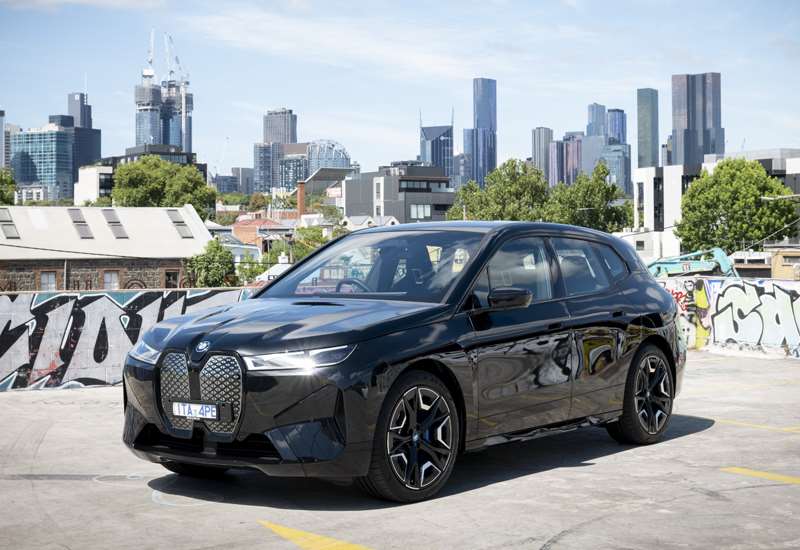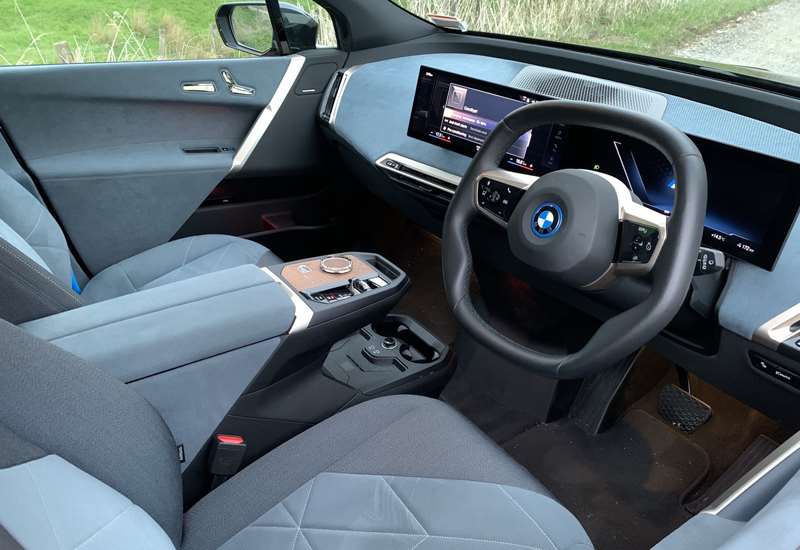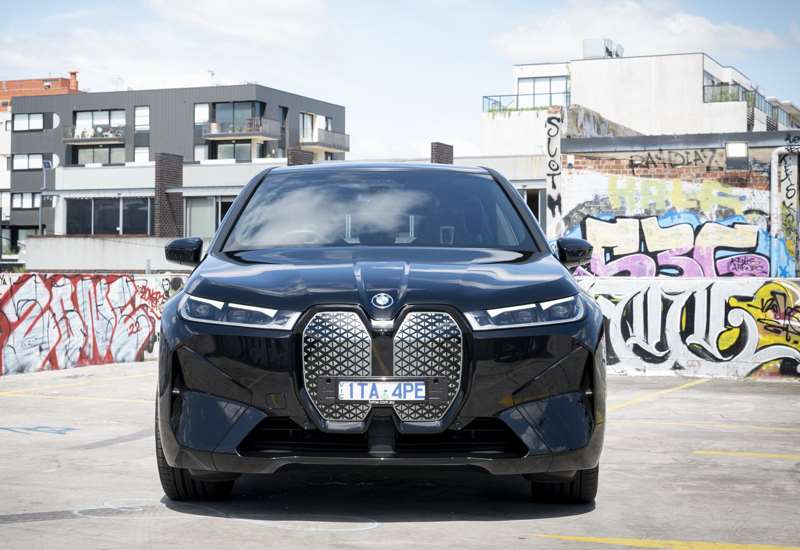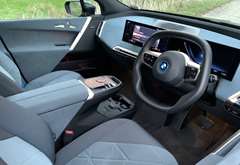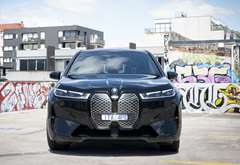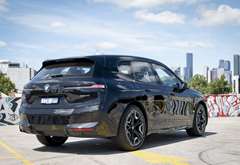Keeping relevant barometers in mind is always appropriate, yet with BMW’s iX, does that just confine us to the Audi e-tron, Mercedes-Benz EQC, Jaguar i-Pace and Tesla Model X?
Look at the i3, Munich’s urban-centric electric, about to be retired after 10 years in production.
As much as there’s no obvious visual similarity, in fact the two BMWs have a lot in common.
Design and engineering approaches are kindred, both being heavily reliant on exotic materials in their build, not least the commonality of body structures using a generous dose of aluminium, high-strength steel and plastic reinforced with carbon fibre.
They are of similar standalone character. When the i3 hit NZ back in 2013, it was an impressive showcase for BMW’s then-latest motor and battery technology and next-generation interiors, and very much one of a kind.
Even though it is here at a time when BMW also now fronts with other wholly battery-compelled product in the sporty i4 and the iX3, the iX is nonetheless as different from the rest now as the i3 was then.
It, too, is also a 100% standalone model designed from the outset to be electric. It will not be offered with a petrol engine or as a hybrid.
As part of this test, I invited an i3 owner to examine and drive the iX. It proved a fascinating and worthwhile exercise.
There’s no argument an iX, at technical level, reaches into places the i3 development crew could only dream about, yet the baby seems remarkably resilient to age.
That my guest intuitively knew his way around much of the iX’s operability reminds how advanced the i3 was, and in some ways still is.
Timing for the iX is good because times have changed.
The i3 landed when electric was still a novelty and, with just 250,000 built, failed to imprint as much as Munich hoped. The iX cannot be considered a gimmick, it has a solid support network and, more importantly, the audience is genuinely interested.
The xDrive40 on test is the starter; it’s fitted with a 76.6kWh battery for a cited range of up to 425km.
It can also be rapid-charged at up to 150kW from compatible chargers.
Dual motors provide up to 240kW/630Nm for 0-100kmh acceleration in 6.1 seconds.
Being the least expensive iX doesn’t make this version cheap.
It sits above most rivals. The test example especially so, as it was heavily optioned: Blue seat belts, 22-inch alloys, interior camera, glazing options, soft-closing doors, tow bar, laser light headlamps and a panoramic sunroof pushed the spend to $182,300.
Does the shape need much discussion beyond acceptance that BMW design is polarising? The grille — or, more accurately, a panel that is of a grille shape (it’s solid because there’s no engine to cool and also to protect a host of driver-assist electronics behind) — is challenging.
The surfacing of the sides, the frameless doors and the shape of the side glass also draw comment.
Debate likely won’t settle when moving inside; everything in there is at the edge of future-dom, too.
A wheel shaped like a round hexagon is OK to hold and lends a good view of the instruments behind, but someone is going to mention the Austin Allegro.
In some ways it might seem amazing the iX is purely a five-seat vehicle, as its interior is convincingly generous. Everything lends a good reminder why electrics — with no need for a transmission tunnel or driveshaft allowing a truly flat floor — are such winners for spaciousness.
This car’s sunroof did restrict headroom, but legroom was simply not an issue and the place felt impressively airy.
Interior trims give BMW the opportunity to use the iX as a sustainability exercise; you can have real or fake or take, as here, a soft microfibre fabric on the seats and a fuzzy felt on the dash and door tops. Does it look truly expensive? Not really. But think of the planet.
There’s now just a small floating centre console between the driver and passenger. The dashboard itself is dominated by a wide display that spans from behind the steering wheel towards the middle of the fascia.
This display is running the latest iDrive 8 software with about 20 times the computing power of previous models.
There’s no traditional gearstick because electrics don’t need that sort of thing and though it maintains the trad iDrive rotary controller — this one rendered in crystal glass, as were the seat controls and start/stop button — to activate core menu options, it will prefer voice control if you’re happy to try using it.
It is not that daunting and, besides, chat avoids putting finger marks on the BMW curved display, a massive slab of anti-reflective glass that appears to float above the main dashboard fascia and is the portal to everything. Don’t be overly concerned the infotainment section is very heavily populated by icons; most just access sub-menus unimportant to actual driving.
The ‘‘My Modes’’ personalisation options are fascinating.
You can create your own profile and have the car tailor itself to your personal tastes well beyond setting up the seat and steering wheel position just so.
Beyond that, you can set up password-protected personal internet and comms.
Navigation uses the cloud-based BMW Maps and Augmented Reality Video in the control display. In addition, five cameras, five radar sensors and 12 ultrasonic sensors are used to monitor the vehicle’s surroundings.
A remote theft recorder is a feature. There’s a lot going on. As much as adjusting the interior temperature via the touchscreen or voice control will impress passengers, I did miss not having access to physical buttons for the climate control.
BMW determined that the iX should offer the comfort of a 7-Series limo and the handling of a 5-Series sedan, in one X5-sized package.
From this experience, I’d say it’s closer to hitting the first goal than the second. The influence of the dynamics is, of course, the mass that has to be controlled. Yet the cohesive way the iX drives is nonetheless impressive. A low-slung battery pack, stiff construction and well-tuned suspension help mitigate the 2.5-tonne weight. With most of its kilos under floor, on good surfaces, the iX feels settled and regal. Nasty bumps can disrupt the schmooze. The air suspension delivered to the xDrive 50 would resolve that trait.
Inevitably, you do feel the car’s bulk, not least when you turn into a corner at speed. Yet it is nonetheless a BMW you can look forward to driving because that CRFP structure lends impressive rigidity. You only really sense the weight at work under heavy braking.
Variable ratio steering is fitted to all iXs as standard and it really suits the car, making it feel more agile around town and through tight corners as the steering speeds up the further away from straight ahead you turn the wheel.
Realistically, it’s the difference in range between the variants here now that I could imagine becoming the core factor dictating which becomes more preferable.
It’s impossible to say without having the opportunity to drive it how close the xDrive50 comes to realising the ‘‘up to’’ 630km range that testing to WLTP standard suggests is possible.
However, on the strength of what the xDrive40 indicated during test, there’s reason for doubt. The 425km WLTPmeasured range BMW has shared as a cited accomplishment was always well out of reach.
I twice charged the battery to an indicated 100% replenishment — a process that initially took two hours with the oomphiest charger in my location, a 50kW ChargeNet outlet — and on both occasions it indicated a maximum range of 375km.
From past experience, that leaves the xDrive40 in the same position as the Audi e-tron S, a tri-motor, and slightly advantaged over the Mercedes EQC. You’d certainly be capable of using it for extended open road driving but, really, would always want to plan a route that allowed for top-ups.
Hard to say if this is the best premium electric SUV around. But it certainly is an especially fascinating choice and, quite potentially, the quietest. Much of the design detailing is exquisite and, occasionally, delightfully eccentric: Pushing down on the bonnet badge, when the car is unlocked, opens to the windscreen washer refill tube.
Like the i3, it’s an electric that sets out to stand proud.
- Richard Bosselman. Photos: Supplied
